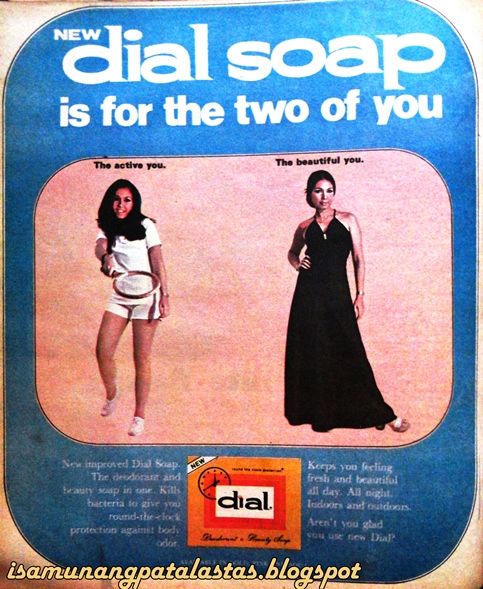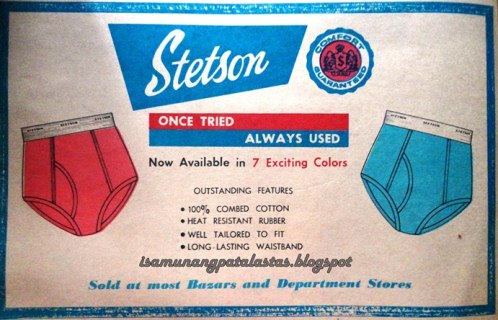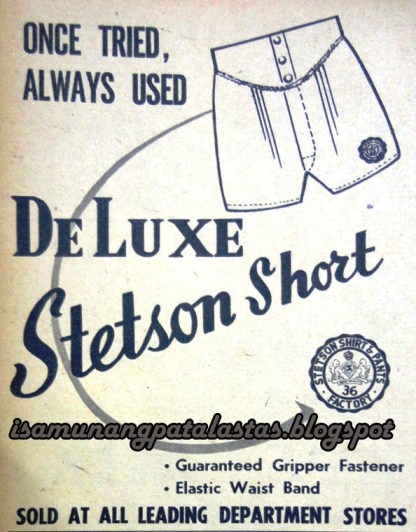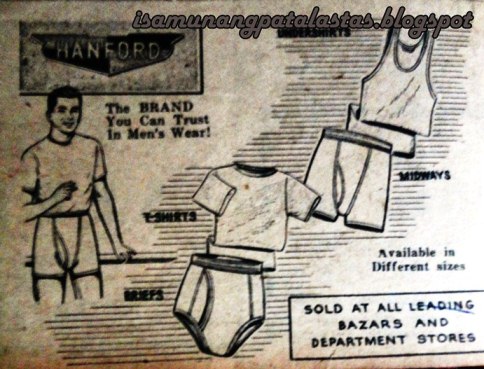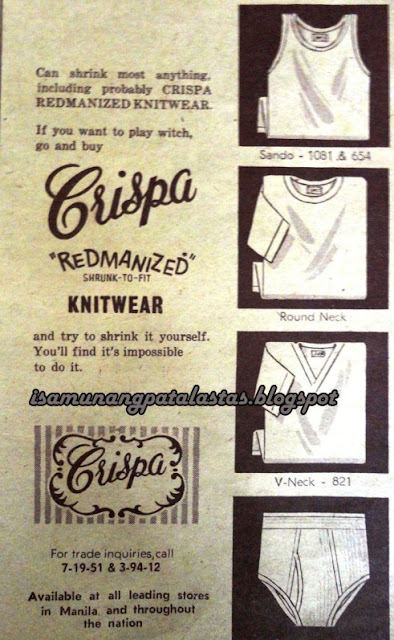A brand name
defines and differentiates a product from its competitiors in the eyes of the
customer. So important are brand names that they can make or break a product---a
car manufacturer once named its new vehicle “Nova”, not knowing that “no va”
meant “not going” in Spanish. On the other hand, there are perfect brand names
like “Jollibee”, “Hapee” and “Mr.Clean” that evoke positive images of joy,
clean living and fun. Before marketing experts offered their brand-naming
services, many makers of products just coined their own brand names, resulting
in odd, unusual names.
***********
1. ATOMI-CHLOR (Anti-fleas
and ticks)
This liquid product, designed to rid pet dogs, insects,
plants and lawns, was forlumated in the 1950s –known as the Atomic Age—hence
the brand name ATOMI-CHLOR. The other half is derived from its active
ingredient—Chlordane. The ad dates from 1951.
2. BARRY’S
TRICOPHEROUS (For baldness, thinning hair and dandruff)
BARRY’S
TRICOPHEROUS was introduced in the late 1840s by "professor" and
former New York wig-maker, Alexander C. Barry. The product surprisingly did
well in the market and was sold to Thomas Barclay in 1871, who sold it until 1906. The product contains 97% alcohol,
1.5% castor oil, and 1% tincture of cantharides (Spanish fly), which supposedly
help stimulate the scalp’s blood supply. The product is still being sold today.
Ads from 1951.
3. DUSGOCYL (For
cough relief)
The name of this cough relief medication is a challenge
to spelling bee contestants; DUSGOCYL
sounds like the name of a prehistoric creature, a winged dinosaur perhaps—not some
product that “combats cough at the start”. It actually contains Cocillana,
which has expectorant properties. Curiously, it also lists wild lettuce as among
its ingredients. Ad from 1935.
4. ELIXIR AURI-BROMIDE
(For all acute and infectious coughs)
This elixir has a unique 24K gold tri-bromide ingredient
from which its brand name was derived. “Aurum”, the chemical symbol for gold,
plus “bromide”, resulted in ELIXR
AURI-BROMIDE, that provides soothing relief for whooping coughs, bronchial
asthma, pulmonary and other obstinate coughs. Ad from 1961.
5. GALISATUM (For all
diseases of the skin)
GALISATUM was
a skin ointment developed by Dr. Carlos Jahrling of Botica Sta. Cruz in the
1930s. “Galis” was an all-encompassing
local term for any skin conditions—from
scabies, eczema to skin chafing and mange.
“-Atum” was a suffix that was
commonly used in pharmaceuticl products
like “mentholatum”and “petrolatum”. Ad from 1936.
6. JAGGING JAGGING
(Face Powder)
There really is no reason why
a cosmetic product guaranteed to make
you “lovely to look at” be named JAGGING
JAGGING. It is nonsensical, unfeminine and the sound is far from
mellifluous. But Chun Huat Pomade
Factory, the manufacturer, did just that, making it hard to believe that
Jagging Jagging is indeed, a “girls’ favorite”. Ad from 1934.
7. KULSO-ALIS
(Anti-diarrhea, anti-dysentery)
Another product coming from Botica St. Cruz is KULSO-ALIS,
a concoction with a brand name that comes from “Kulso” (diarrhea, loose bowel
movement) and “Alis” (to be free from, begone). It was a common way to coin
brand names for products—Katialis, the popular skin cream was coined in the
same way. It is interesting that Kulso-Alis lists Opium as one of its
ingredients. Ad from 1937
8. MONG ALING (Remedy
for anemia)
This medicine intended for a serious disease has such a
comical-sounding name, that it’s hard to believe it can bring relief to anemic
women and mothers with disorders associated with pregnancy and their menses.
Even the ingredients do not give a clue as why it was named MONG ALING. To make it more difficult
to decipher, the word and numbers “Silang Lab.
No. 8368”, are appended to the brand name. Is this a trademark
registration number? It remains a mystery to this day. Ad from 1936.
9. ODORODO (Body odor
protection)
The brand name of this early deodorant spray is a
palindrome—ODORODO—it reads the same
way when read backwards. Such literary devices were used to increase
memorability of the brand name, but unfortunately Odorodo, even with its catchy
name and unque Action-Proof formula, did not catch on. But at least, the
euphemistic “B.O.” (for body other) is still in our vocabulary today. Ad from
1960.
10. PENETRO (For chest
colds)
St. Joseph Laboratories gave us this medicated rub
with the name PENETRO, which conjures images of soothing, penetrating vapors to
give relief to chest colds. But it is also ideal for tired feet, burns and
other aches, which makes ”Penetro” very
apt, as it does sound almost like a name for a multi-powered superhero! Ca.
1935.
11. REUTER’S SOAP (Skin Soap)
The early toilet soap designed to beautify a woman’s
complexion is a trademark of Lanman & Kemp-Barclay & Co., Inc., The
company, itself was founded in 1808 by Robert I. Murray and its business was
conducted under the firm name Murray & Lanman in New York. The brand name--REUTER’S SOAP-- has nothing to do with the world-famous news
bureau. It was named after its creator, Dr. John Reuter. The classic bar soap
was sold under its Spanish brand name, Jabon de Reuter, in the Philippines. The
company still is in cooperation today with headquarters in Westwood, New
Jersey, and continues to sell the soap. Ads from early 1950s.
12. SAIZ DE CARLOS
(Stomach elixir against gas and diarrhea)
It would seem at first that this brand name came from
someone named Carlos the Sixth. However,
the famous stomach elixir bears the name
of its maker, pharmacist and doctor Ramón Sáiz de Carlos (b.26 Jan. 1857) whose interest in oenological
research led him to pursue laboratory work and develop new medicines and drugs.
The acclaimed Sáiz de Carlos gave his
name to such new products that were exported all over the world---Neuranémico,
Dinamogeno, Reumator, Purgantina,
Quinofebrina and the popular SAIZ
DE CARLOS ELIXIR ESTOMACAL, recommended for gas pains and diarrhea. In the
Philippines, the product was distributed by Metro Drugs.
13. SUSPIRO DE AMOR
(Women’s perfume)
Not a exactly an odd name, but certainly mysterious, if
not sensual. SUSPIRO DE AMOR—“Sigh of Love”—is the brand name of
this lady’s perfume guaranteed to arouse passion and love. Even the ad copy is
full of innuendos—“the lady languishes on her silken couch—she murmurs in accents of
wild sweetness—“Midnight and after!”. Ad from 1951.
14. TIMOSINA (For
cough relief)
Thymosins, small proteins in animal tissues, were
originally isolated from the thymus, hence the name. They are used in
mucolytics and expectorants to clear coughs, improve hydrations and volume of
secretions. TIMOSINA Cough Syrup, a product of the pharmaceutical company in
the Philippines—Botica Boie-- is the
Spanish term for thymosin. It is indicated for convulsive spasms of whooping
coughs. Ad from 1953.
15. VIN DÉSILES
(Energy drink)
The brand name of this revitalizing drink popular in the
1950s seem anachronistic as it sound like the name of contemporary Hollywood
action star, Vin Diesel. VIN DÉSILES,
which claims to restore energy and appetite, was distributed by Oceanic
Commercial, Inc. in the Philippines. ca. early 1950s.
